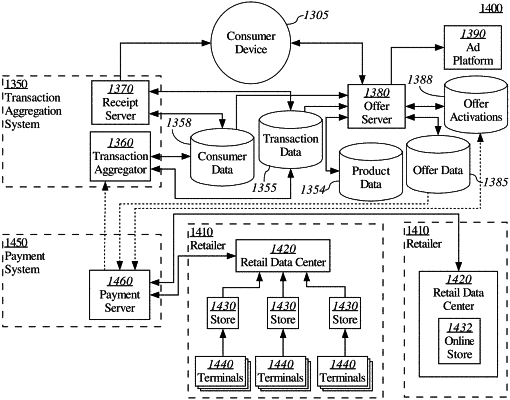| CPC G06Q 30/0255 (2013.01) [G06Q 30/0201 (2013.01); G06Q 30/0269 (2013.01)] | 16 Claims |

|
1. A computer-implemented data processing method comprising:
using an offer server computing device, obtaining a first consumer record associated with a first computer source and a second consumer record associated with a second computer source, each consumer record comprising key information and contextual transaction data, the first computer source comprising a merchant point-of-sale terminal or card reader or a digital receipt source, the second computer source comprising a service provider website or loyalty data source; the first consumer record and the second consumer record having been obtained by a retail computer system accessing an API hosted by the offer server computing device directly in real time as transactions occur at the retail computer system;
wherein the first consumer record is a first master record of a first entity and the second consumer record is a second master record of a second entity;
using the offer server computing device, normalizing the key information;
using the offer server computing device, in response to determining that the first consumer record has been obtained from a primary source, determining that at least a first set of key information in the first consumer record matches a second set of key information in the second consumer record, and in response thereto:
using the offer server computing device, identifying the first set of key information in the first consumer record that matches the second set of key information in the second consumer record and separating noncontradictory key information, the noncontradictory key information being the first set of key information from the first consumer record that matches the second set of key information from the second consumer record;
using the offer server computing device, creating and storing a third master record in a database, the third master record comprising a union of the first consumer record and the second consumer record and a plurality of master record key values;
using the offer server computing device, creating and storing a score value for the third master record based upon a plurality of score values that are assigned to each of the master record key values, the score value indicating a level of confidence that the first set of key information and the second set of key information refer to a same particular consumer and including generating the score value by calculating a proportion of the key information in the first and second consumer records that comprises the first set of key data and the second set of key data;
using the offer server computing device, increasing or decreasing the score value based on machine learning techniques and either or both of: a determination that the noncontradictory key information from the first consumer record and the second consumer record also is in a third consumer record, or receiving a validation signal indicating that a consumer has validated the noncontradictory key information;
wherein the first set of key information comprises a first identifier that matches a second identifier in the second set of key information, and further comprising increasing the score value of the third master record based upon determining that both the first identifier and the second identifier are in the third consumer record;
using the offer server computing device, ranking a plurality of master records, including the third master record, based on trustworthiness of the score values assigned to each of the master record key values and assigning the value of the highest-ranking score to a particular master record;
using the offer server computing device, using the third master record to determine one or more electronic offers to present to any of a user, a computing device, or an account that is associated with the third master record, the determining the one or more electronic offers being based on at least one of: an activity associated with the particular master record or a consumer attribute associated with the particular master record;
using the offer server computing device, generating a webpage comprising an electronic receipt with embedded offer information formatted using one or more of XML, SOAP, or JSON and at least one uniform resource locator (URL);
causing presenting the one or more electronic offers that were determined.
|